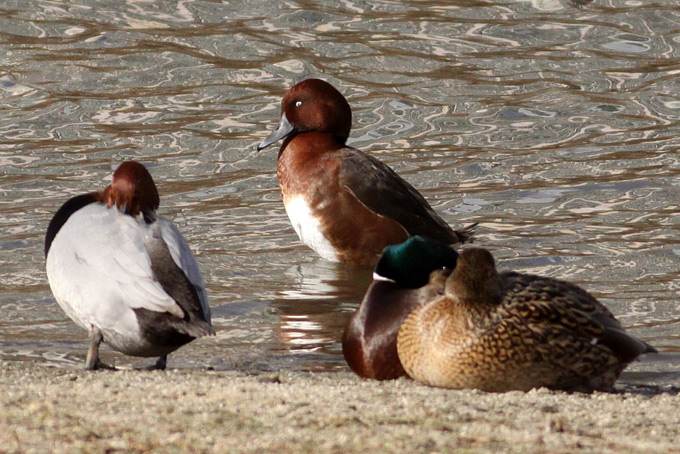 | E-mail to Birds Korea |
 | KWBS |
in the Region
 | The Oriental Bird Club |
 | BirdLife International (Asia) |
January
In occasional periods of extreme cold smaller rivers and reservoirs freeze over. Temperatures throughout the nation often drop to -5°C or colder at night (occasionally down to -25°C in Cheorwon), and stay near freezing in the day. Periods of light snow and severe cold are usually followed by milder temperatures for a few days and then severe cold again.
Mid-winter specialties include Baikal Teal (in often huge concentrations), and small numbers of Scaly-sided Merganser, Swan and Lesser White-fronted Goose, Steller’s Sea Eagle, Relict and Saunders’s Gulls and Solitary Snipe. There are flocks of Red-crowned and White-naped Cranes in the Cheorwon Basin and Hooded Cranes at Seosan and Suncheon in the south, and also huge numbers of ducks and geese, especially towards the southwest. Milder conditions on the southern island of Jeju allow species like Black-faced Spoonbill, White’s & Pale Thrushes, and even taivana Eastern Yellow Wagtails to overwinter. On the East coast, there are plenty of gulls to check through, and favoured seawatching areas such as the Guryongpo Peninsula and north Gangwon Province provide chances to see Yellow-billed Loon, Long-billed Murrelet and Spectacled Guillemot along with occasionally large numbers of Ancient Murrelet and smaller groups of Rhinoceros Auklet.
National highlights in recent years have included Lesser Whitethroat, Asian Rosy Finch, Red-crested Pochard, and White-bellied Green Pigeon.
Recent national firsts found in January have included Plumbeous Water Redstart (2006), Desert Wheatear (2008), King Eider (2009) and Bufflehead (2013).
Songdo in winter
When does winter start in Songdo? For me, it is when the Great Cormorants disappear. This year, at least 200 were lined up on the islands and mudflats on Dec 1st. Two weeks later all had gone. I don’t think they go far. A colleague recently reported 300 flying along the Han river in Seoul. But in mid-winter, Songdo is cormorant-free. Waterfowl and shorebird numbers seem quite stable throughout the winter. Here are my counts.
- Bean Goose (35 on 2 Feb)
- Common Shelduck (1,000 birds wintering, numbers very steady and many more than last winter)
- Ruddy Shelduck (210 at Namdong Reservoir on 31 Jan)
- Gadwall (20)
- Falcated Duck (2 pairs, Namdong Reservoir on 11 January)
- Mallard (Perhaps 800 in the area in January, many more than last winter)
- Eastern Spot-billed Duck (500 in mid-December, but numbers lower subsequently)
- Northern Shoveler (500)
- Northern Pintail (100)
- Eurasian Teal (300, almost exclusively on Namdong Reservoir)
- Common Pochard (500)
- Tufted Duck (Up to 10)
- Greater Scaup (15)
- Common Goldeneye (50)
- Smew (2)
- Common Merganser (Up to 30)
- Red-breasted Merganser (10)
- Little Grebe (3)
- Great Crested Grebe (1 wpl on 2 Feb, I think my first for Songdo)
- Grey Heron (up to 18)
- Common Moorhen (Unusually, 2 up to 11 Jan, but not since)
- Eurasian Coot (7)
- Eastern Oystercatcher (10, up to 15 Dec, gone now I think. Last year Dunlin and Grey Plover also wintered but this year I have not seen any)
- Eurasian Curlew (the only wintering shorebird, with up to 700 birds)
Yesterday, 2 February, while visiting Namdong Reservoir, complete with AI Warning Signs (the signs were put up by Ministry of Agriculture around the reservoir, I wasn’t personally carrying AI warning signs.

I looked up at the bare trees on the island to see 4 Great Cormorants, looking very handsome in their white-faced breeding dress, perched there. So maybe spring is coming ! However, when I looked up again they had gone, so perhaps they don’t really think it is spring at all …..
Yongjeong, January 31
Given the increasing disturbance by recreational fishermen and numerous spent shotgun cartridges scattered along its banks, it is not surprising that the western reservoir near Wangsan held significantly reduced numbers of wildfowl. Counts -which can be compared to last year- included the following:
- Taiga Bean Goose Anser fabalis. Up to 500 Beans (presumed to be of this taxon due to apparent long-billed appearance, although of variable neck length) roosted on the open reclaimed area and later flew to the saltpans.
- Whooper Swan Cygnus cygnus. 23.
- Gadwall Anas strepera. 14.
- Falcated Duck Anas falcata. 210.
- Eurasian Wigeon Anas penelope. Ten.
- Mallard Anas platyrhynchos. Eight.
- Northern Pintail Anas acuta. One.
- Common Pochard Aythya ferina. 120.
- Tufted Duck Aythya fuligula. Six.
- Common Goldeneye Bucephala clangula. 11.
- Smew Mergellus albellus. One.
- Common Merganser Mergus merganser. 11.
- Hen Harrier Circus cyaneus.
- White-tailed Eagle Haliaeetus albicilla. Two circling over the reservoir.
- Eastern Buzzard Buteo japonicus.
- Eurasian Coot Fulica atra. 680 on the reservoir.
- Eurasian Skylark Alauda arvensis. Five on the stony reclaimed area.
- Eurasian Wren Troglodytes troglodytes. Several noted.
- Meadow Bunting Emberiza cioides. A pair in the reeds.
- Pallas's Reed Bunting Emberiza pallasi. Ten or so.
- Common Reed Bunting Emberiza schoeniclus. 15+


Seogwipo, Jeju Island, January highlights
I have been checking my local Seogwipo patch daily for the past month. It’s been an unseasonably warm and hazy January, with double digit temperatures most days. I haven’t encountered anything unexpected, but Jeju has a nice mix of winter birds to see, some of which are not so common on the mainland at this time of year.
The hills are alive with…tits! Varied, Long-tailed, and Coal Tits are exclusively found up at higher elevations, while Eastern Great Tits are widespread in wooded areas and parks. A White’s Thrush has been spotted several times at a dry riverbed that in summer is home to Japanese Paradise Flycatchers. I’ve also encountered several Bramblings at higher elevations, whereas Eurasian Siskins and Grey-capped Greenfinch can be found reliably in several parks around town.
These parks also feature Little Grebe, Green Sandpiper, White-backed Woodpecker, Red-flanked Bluetail, Daurian Redstart, White and Grey Wagtail, Olive-backed Pipit, Japanese White-eye, Blue Rock Thrush, plentiful Yellow-throated Bunting, as well as an overwintering Striated Heron. Pale Thrushes can be heard burbling through most areas with shady undergrowth, but rarely seen, as they are quite shy. On the 29th I witnessed a group of close to 20 Mandarin Ducks awkwardly feeding on fruit in a large riverside tree – quite a spectacle!
In and around the harbour, several Common Sandpiper, Pacific Reef Herons Egrets, Mandarin Ducks (120+), several Gadwall, Mallard, Spot-billed Duck, Eurasian Teal, a Common Pochard, as well as Common Coots, several Black-crowned Night Heron, and a Red-throated Loon. On the coast, Great Crested and Black-necked Grebes can be seen relatively close in to shore at a number of sites.
Recently I was surprised to hear the exotic ‘summer song’ of the Japanese Bush Warbler – very early in the year I thought (January 27). Usually at this time of year they can be heard ‘check-check-checking’ from the underbrush. Their ‘winter call’ is very similar to the Eurasian Wren, a bird which can be found at several quiet riverside sites around town.
On the 30th near Jungmun, I found a flock of almost two dozen Red-billed Starlings perched on wires, competing for berries with Brown-eared Bulbuls. Nearby, a small band of personata Black-faced Buntings moved through thick underbrush on a quiet riverside. White-cheeked Starlings, Chinese Grosbeaks, and Dusky Thrushes have been conspicuously absent from Seogwipo this winter. Raptors were represented in January by several pairs of Eastern Buzzard, a Eurasian Sparrowhawk, several Peregrine Falcons, Common Kestrels, and a Northern Goshawk.


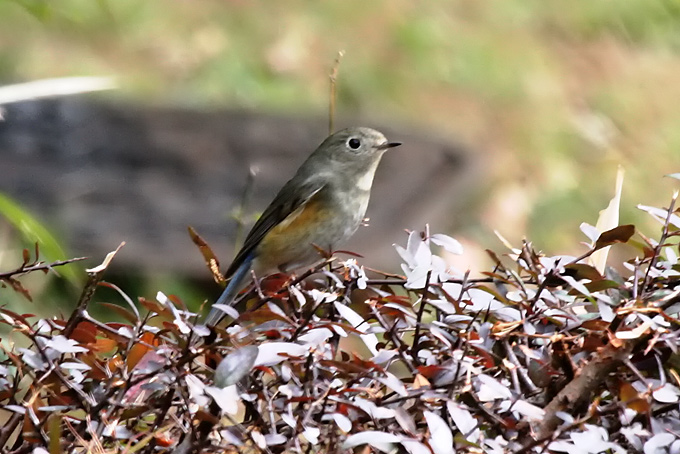



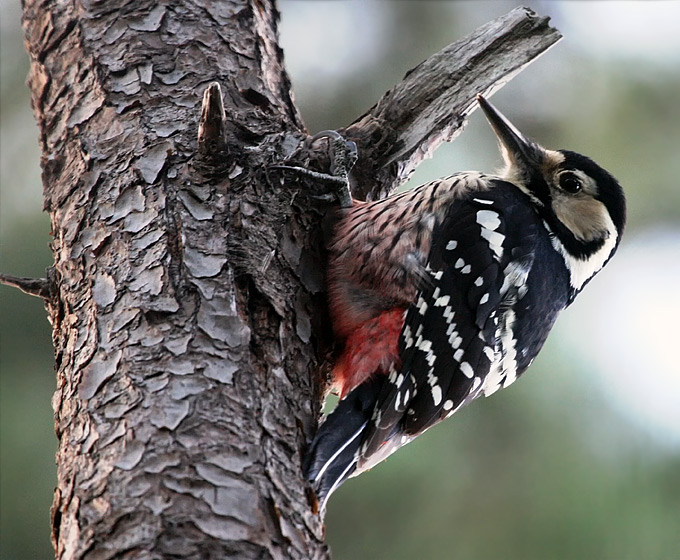

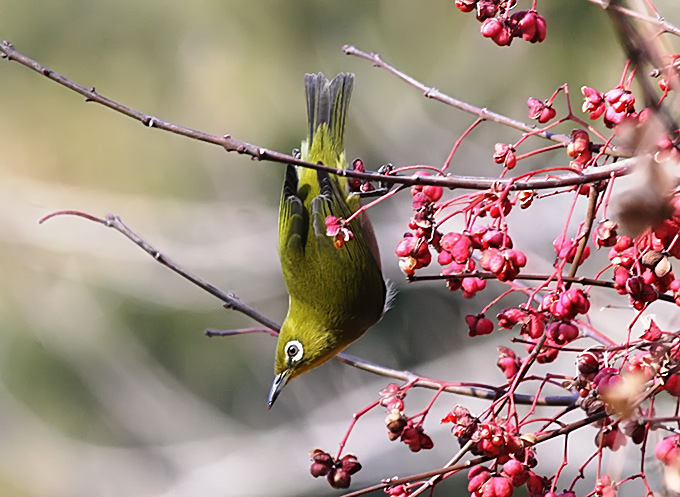


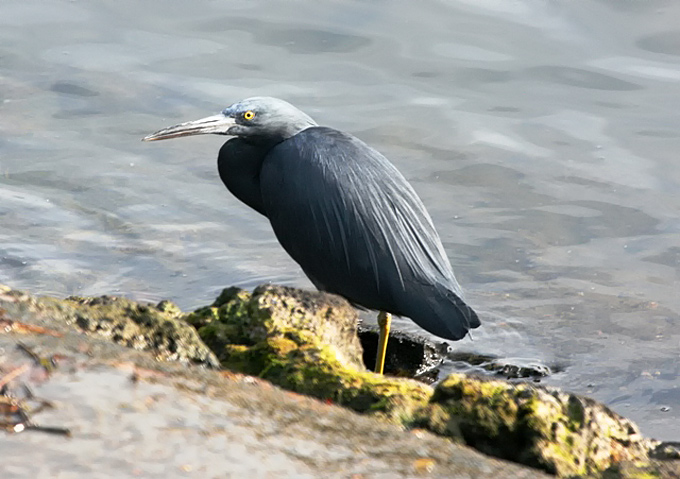
Seoul, January 27
At the crack of dawn I was in Amsa Eco-Park to see Korea's second European Robin (apparently present for a week or more?) dart out of a thicket for ten seconds and then head off to feed. It was hard to believe my eyes- I'm used to seeing this cheerful sight only in western Europe. Also here, the clockwork sound of Azure-winged Magpies winding down in the willow trees.
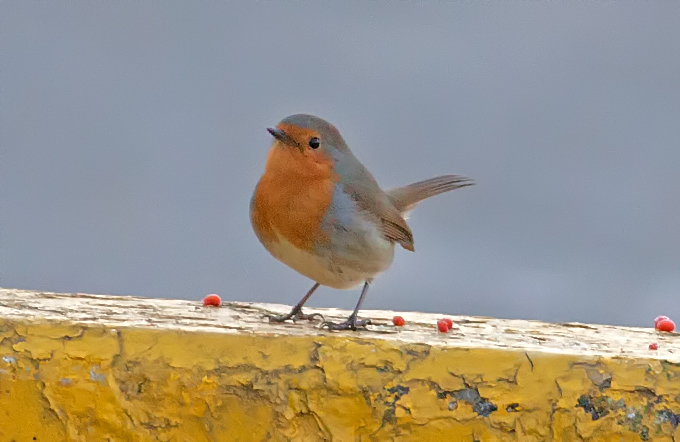
Later at the Jungnang Stream, where 4600 Tufted Duck and 126 Mandarin Duck, two odd-looking aythya. One basically resembling Baer's Pochard but with cinnamon tints on the head. Yesterday an apparently different individual, which looked more pure-blooded (in the pictures at least) was photographed here. Nearby, an apparent hybrid Ferruginous Duck, perhaps with some Common Pochard influence.
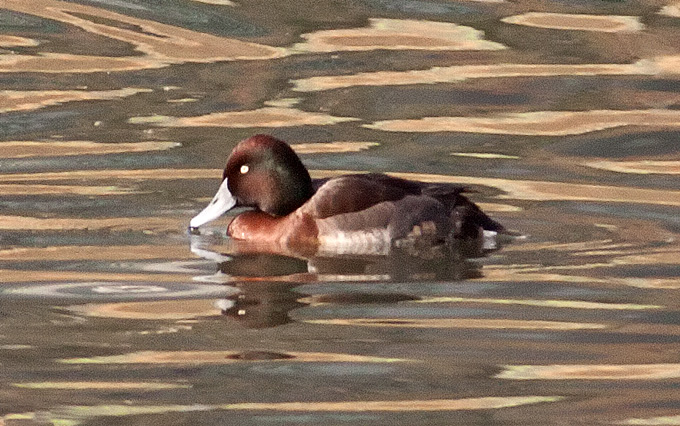
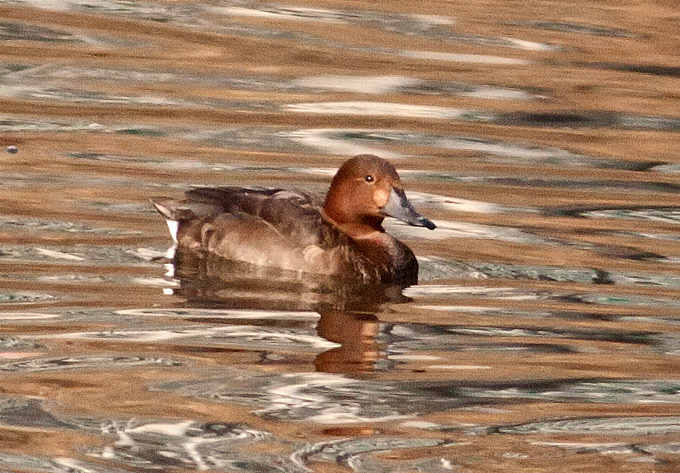
Various Sites, January 11 - 24
As part of the Birds Korea survey on Scaly-sided Merganser, we visited various inland riverine sites from January 11th -14th; and again for part of January 19th and 22nd. In addition, we visited the north-east coast (where joined for some of 15th and most of 16th by Jason Loghry, Tim Edelsten and Jang Ji-Eung); the south-east and south-west (joining up with Andreas Kim for several hours on the 21st) and northern-central sites again on 23rd and 24th (when joined by Roger and Julia Labbett). In total, we recorded approximately 175 species. Outstanding highlights included finding the ROK’s first Ring-necked Duck (accompanied by a puzzling small scaup); several Caspian Gull; national high counts of three alcid species (as described enthusiastically by TE mid-month); three overwintering Barn Swallows and a new national high count of Pine Bunting. Less positively, in addition to increased disturbance of waterbirds being caused by “scientists in white suits” trying to disinfect Anatidae sites, there is clearly yet another road-building and land-clearing boom taking place, with bulldozers in action at many of the sites we visited – this despite the many near-empty roads and unfinished buildings encountered nationwide.
Among the most notable bird records:
Swan Goose Anser cygnoides. Fifteen were at Suncheon Bay on 21st and 32 were at the Geum Estuary on 22nd.
- Lesser White-fronted Goose Anser erythropus. One was at Suncheon bay (NM only) and probably 10+ were found in Haenam County on 21st and 22nd.
- Whooper Swan Cygnus cygnus. An adult with a red-neck collar, with F16 in white, was on a river at approx. 37.13.516 N, 127.44.638 E on the 12th.
- Ruddy Shelduck Tadorna ferruginea. A flock of 110 on the Imjin River was a decent count of this fast-declining species.
- Gadwall Anas strepera. A flock of 1,400 was on Gocheonam Reclamation Lake, Haenam, on 21st.
- Ring-necked Duck Aythya collaris. A female was found on the river at Chungju on the 13th. Photographed by EK, this is the first record of this species in the ROK, and will be added to Category 1 of the Birds Korea checklist during the next update.
- Scaup sp. Remarkably, a small scaup recalling Lesser Scaup A. affinis was seen for a time feeding alongside the Ring-necked Duck on the 13th. Smaller than Tufted Duck A. fuligula, with a peaked rear crown (more evident at some angles than others) the bird also appeared neater, more richly-colored and smaller-billed than five Greater Scaup A. marila and several “scaup-faced” Tufted Duck present in the same flock. On one brief view of the upperwing, NM noticed grey “somewhere in the outer primaries” and disgiscoped record shots of the bird wing-flapping suggests some contrast between inner (white) and several of the outermost primaries; as well as rather dark-looking undersides to the primaries. A follow-up visit on the 23rd failed to find this individual. Informed comments welcome!
- Bufflehead Bucephala albeola. As noted by TE, last winter’s male was back in the same corner of the same lake in Sokcho on 15th.
- Scaly-sided Merganser Mergus squamatus. In all, we found 115 “Scalies” (out of the total 149 recorded by the Birds Korea survey this winter).
- Red-throated Loon Gavia stellata. One was well inland on the river in Chungju on the 14th.
- Yellow-billed Loon Gavia adamsii. One found off the Daejin lighthouse on the morning of the 16th was relocated later the same evening in the harbour by JJE.
- Oriental Stork Ciconia boyciana. One was present in Haenam County on the 20th and 21st.
- Cinereous Vulture Aegypius monachus. About 100 were seen on the 11th, with smaller numbers recorded at other sites in the far northeast and southwest and in Cheorwon.
- Eastern Imperial Eagle Aquila heliaca. A rather shy adult was seen well in Haenam County on both the 20th and 21st.
- Golden Eagle Aquila chrysaetos. An adult soaring over Chungju Reservoir on the 14th was a surprise find.
- Black Kite Milvus migrans. One at Suncheon Bay on 20th was NM’s personal first at this site.
- White-tailed Eagle Haliaeetus albicilla. Found on several rivers and near the coast in the far northeast. Numbers encountered during this survey suggest that perhaps ~200 (?) are overwintering nationally this year.
- Steller’s Sea Eagle Haliaeetus pelagicus. An adult sitting on ice in Pohang on 18th, sandwiched in between new roads and other infrastructure, and an adult at Paldang on 23rd were the only ones we encountered.
- Merlin Falco columbarius. One near Imjingak on the 11th (EK only) and a male and female sitting within 100m of each other on telegraph wires in Cheorwon County on 24th seem noteworthy.
- White-naped Crane Grus vipio. Despite all the bulldozing and noise in Cheorwon, we saw about 290 there on the 24th, with 26 on the Imjin River near Paju on the 11th and c.70 at the Junam Reservoirs on the 18th
- Red-crowned Crane Grus japonensis. Two were on a river near Wonju on the 13th and about 75 were counted in Cheorwon on the 24th.
- Common Crane Grus grus. One First-winter was at Suncheon on the 21st.
- Hooded Crane Grus monacha. At least 583 (including multiple hybrids) were present in Suncheon Bay on the 21st.
- Solitary Snipe Gallinago solitaria. Only two were seen at the national arboretum, where >100m of the river has been re-engineered, with gabion mattress and dredging since December for now destroying part of the 400m of river preferred by the species.
- Relict Gull Ichthyaetus relictus. Three were in the Nakdong Estuary (EK only) on 19th; and December’s First-winter was still in the Geum Estuary on the 21st.
- Glaucous-winged Gull Larus glaucescens. Probably ten were seen on 15th, with most at Ayajin and Geojin.
- Iceland Gull Larus glaucoides. An adult at Ayajin found earlier by other observers was still present on the 15th. Although its identity was initially questioned by some observers, it showed long primary projection on the closed wing and also a small-headed look (shown well in the images).
- American Herring Gull Larus smithsonianus. An adult found earlier by other observers was watched briefly on Odael beach in Tonghae on the 17th.
- Caspian Gull Larus cachinnans. Identification criteria for this taxon, and its separation from mongolicus, barabensis and possible intergrades, are still being developed and to date there have been probably fewer than five records nationally, all adults, of what seem to be really “good” cachinnans. Best candidates are more obviously paler-saddled than vegae, white-headed in mid-winter, beady-eyed and long-billed, with much white in the outer primaries. On the 15th, a small, pale-saddled, white-headed though quite pale-eyed adult gull with extensive white on the underside of P10 and a large mirror on P9 was found at Gonghyeun Beach, between Ayajin and Geojin. On the basis of its striking appearance but less than striking bill, this individual was identified as a female cachinnans. Remarkably, on 16th perhaps one or two adult cachinnans (again paler-mantled than vegae, and with strikingly long bills) and one or two additional adult cachinnans-types (same as or darker above than vegae) were then found 20km further north at Daejin in a flock of 500+gulls – sharing several features that seemed to rule against other regularly-occurring taxa. On 17th, this gull flock contained three presumed adult cachinnans and a First-winter (much more contrastingly-patterned than any of the thousands of First-winter mongolicus seen over the years), with one perhaps additional adult and one or more cachinnans-types then seen soon after on the beach by the January Pension 3km south. If identification is correct, probably five or more Caspian Gull were present during this period, found in the three gull roosts that were checked out of the many roosts and feeding flocks scattered along this part of the coast
- “Steppe Gull” Larus heuglini barabensis. One Third-winter was at Daejin on the 16th, and an adult was at the Geum Estuary on the 22nd.
- Brunnich’s Murre Uria lomvia. A total of 49 (a new national high-day count) was counted during a 3.5 hour boat trip on the 16th.
- Common Murre Uria aalge. Perhaps four were seen from Geojin headland on 15th , and 26 (a new national high day-count) were logged during our boat trip on the 16th, including one in full-breeding plumage, and two non-breeding plumaged birds swimming within 100m of each other that both showed oddly white-looking napes.
- Spectacled Guillemot Cepphus carbo. Two were seen from land (on 15th and 16th) and two from the boat on 16th.
- Long-billed Murrelet Brachyramphus perdix. One was seen from Geojin headland on the 15th and three were seen together from the boat on the 16th.
- Ancient Murrelet Synthliboramphus antiquus. Approximately 1270 were counted from the boat on the 16th.
- Least Auklet Aethia pusilla. Three or four possibles were seen from the Geojin headland on the 15th (EK and JL only) and 12 (a new national high day count) were counted from the boat on the 16th.
- Eurasian Eagle-Owl Bubo bubo. One was watched calling during the afternoon on the 11th near Jeonkok.
- Eurasian Hoopoe Upupa epops. Two were seen together at the Junam Reservoirs on the 18th.
- Yellow-bellied Tit Periparus venustulus. One was heard (NM only) at the National Arborteum on the 23rd.
- Asian Short-toed Lark Calandrella cheleensis (?). A small and slender-looking lark, perhaps this species, was seen on the shore of the Gumho Reclamation Lake, Haenam, on the 21st. Seen only in flight it appeared to be 20-30% smaller and slighter than the Far Eastern Skylarks Alauda japonica it was with.
- Far Eastern Skylark Alauda japonica. Around 400 were seen in fields north of Ayajin on the 17th: This is the largest flock of this species seen by NM since at least the mid-1990s.
- Barn Swallow Hirundo rustica. Three hawking over the river at Chungju on 14th in temperatures of -8C was one of the most unexpected observations of the trip.
- Chaffinch Fringilla coelebs? Although views were insufficient to confirm identification, an olive-toned Brambling-sized and –shaped finch with two white wing-bars, white outer tail feathers and a plain rump was seen briefly at close range by NM as it flew below an elevated stretch of road by the Geum River just west of Gongju City on the 22nd. It was later presumed to join a Brambling F. montifringilla and fly together south down the river.
- Common Rosefinch Carpodacus erythrinus. A presumed female-type was seen in Cheorwon County on the 24th.
- Common Redpoll Acanthis flammea. One possible was heard in Gangneung on the 15th (NM only); and two were found and photographed at Daejin lighthouse on the 16th. At least one was still present there on the 17th.
- Pine Bunting Emberiza leucocephalos. On the 24th, one or two were heard and seen poorly at Baekma Hill in Cheorwon, and two hours later a flock of 54 were counted near the road 10km east from there. This is the largest flock and the highest national day count of this species known to Birds Korea (Park Jin Young’s 2002 doctoral thesis includes records of 40 seen on February 2nd 1992 at the Imjin River and 30 in Cheorwon on January 18th 1996).
- Ochre-rumped Bunting Emberiza yessoensis. One (or more?) were at Gumho Reclamation Lake in Haenam County on the 21st.
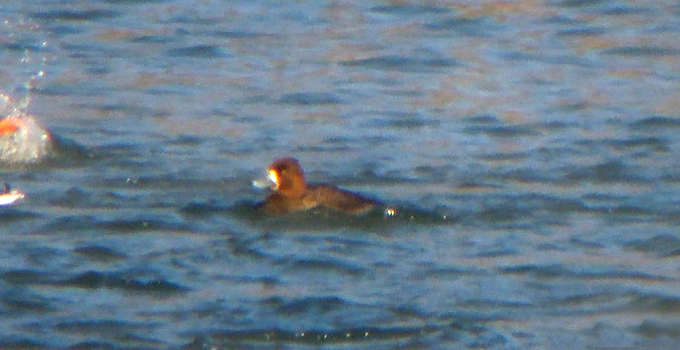




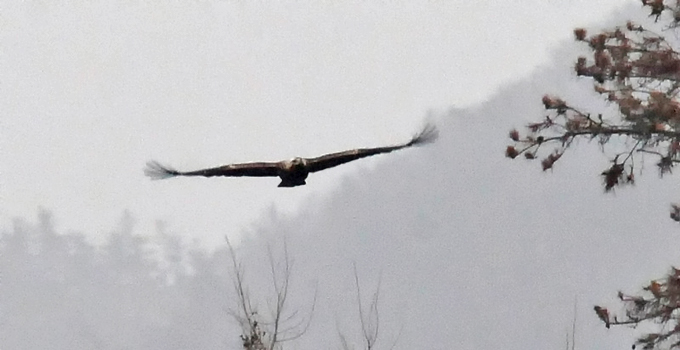




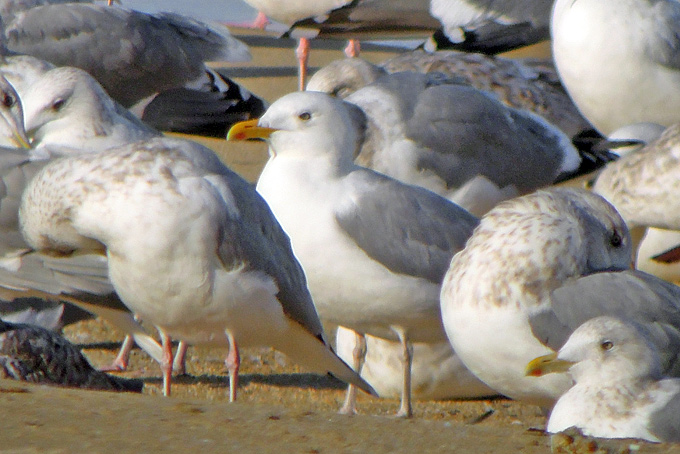


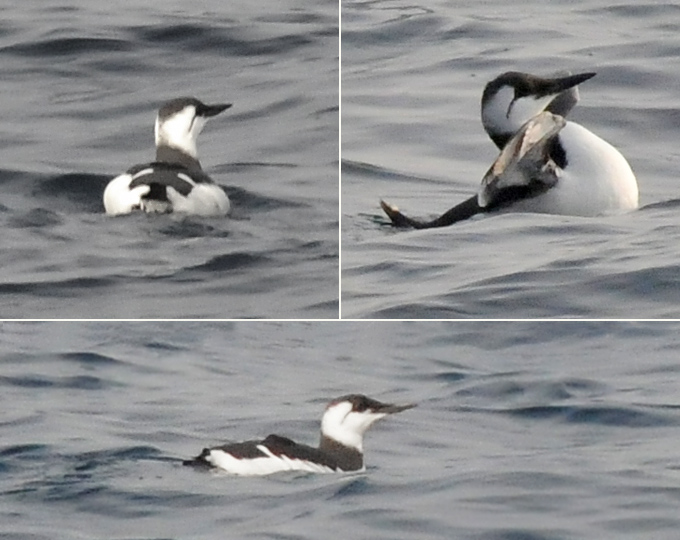
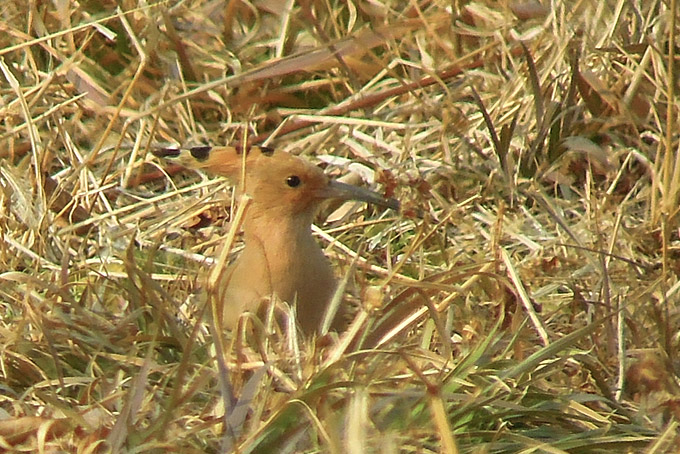



Southern Provinces, East Coast, Chungju and Seosan, January 13 - 17
Focussed survey work in temperatures down to minus 10, along various mostly-frozen rivers on the 13th and 14th was followed by some recreational coastal birding in north east Gangwon Province on the 15th, and a spectacularly memorable pelagic trip from Daejin Port, Hwajinpo on the 16th. On that day excellent calm conditions allowed us to venture some 17-18km offshore, on a trip remarkable for unprecedented numbers of particular species and the unexpected absence of others. The morning of the 17th started out very foggy at Chungju and remained overcast for a brief afternoon visit to Seosan Lakes. Altogether, a lot of fun for everyone involved. Noteworthy observations listed below:
- Whooper Swan Cygnus cygnus. 59 on the reservoir at Chungju and up to 200 on Seosan Lake A on the 17th.
- Mandarin Duck Aix galericulata. Markedly scarce, with only five in total along the Nam River on the 13th.
- Greater Scaup Aythya marila. Two on the reservoir at Chungju on the 17th are remarkably far inland and scarce on freshwater. In addition, an unusual female-type Scaup was seen. In direct comparison to Greater Scaup it appeared noticeably smaller and with darker a head. It was also faster, more pugnacious, and fed and dived far more actively.
- Ring-necked Duck Aythya collaris. Koreas first, a female, was seen well at Chungju on the 17th. It qeued up behind a line of other aythya ducks diving in the rapids.
- Bufflehead Bucephala albeola. A male, undoubtedly the same individual as last winter (when Korea's first record), has returned to Yongrang Lake in Sokcho, where seen on January 13th and 15th.
- Common Goldeneye Bucephala clangula. Seen offshore at Sokcho on the 15th as well as far inland at Chungju on the 17th, with also two in very shallow freshwater near Gyeongju on the 14th.
- Smew Mergus albellus. Concentrated on the Jinyoung reservoir, Jinju and on Gyeongpo Lake, Gangneung.
- Common Merganser Mergus merganser. 163 counted at Jinyoung Lake, Gyeongsangnam Province on the 4th.
- Scaly-sided Merganser Mergus squamatus. Noted at several locations. Our survey work is building a clearer picture of this intriguing species, which seems to show a preference for broad, undisturbed shallow rivers with stretches of rapids and also rocky areas for resting.
- Red-throated Loon Gavia stellata. One seen on Jinyoung Lake, Jinju, on the 14th is an extraordinary record, being not only far inland but also on freshwater. It was very slightly oiled on the breast.
- Yellow-billed Loon Gavia adamsii. One was seen in flight from the boat off Hwajinpo on the 16th. Also on that day, one off the lighthouse in the morning was likely the same individual seen at exceptionally close quarters in Daejin Harbour later in the day.
- Great Egret Ardea alba. A notable count of 204 alba gathered to roost on Jinyoung Lake, Jinju on the evening of the 14th.
- Great Cormorant Phalacrocorax carbo. Large numbers on the Jinyoung Lake, Jinju, although no nests seen.
- Cinereous Vulture Aegypius monachus. One on the sand spit at the mouth of the Namdae Stream, YangYang on the 15th, and one atop a pine tree near the Unification Observatory, Gosong County on the 16th- (where last years Lammergeier was searched for without success).
- White-tailed Eagle Haliaeetus albicilla. Of especial note, an immature was seen attempting to hunt mergansers at Jinyoung lake on the 14th, making low passes and lunges, which the ducks easily evaded by diving at the critical moment. More surprisingly, a full adult was seen in the futile act of diving after ducks at Chungju on the 17th, once again being spectacularly unsuccessful. Other individuals were also seen along the Nam River on the 13th (in a picturesque area with spoor of Eurasian Otter Lutra lutra), from the highway north of Jinju on the 14th, one at Yang Yang on the 15th, and one or two off Daejin on the 16th, where a similar number was said to be seen daily on nearby Hwajinpo lake by Mr. Shin of the January Pension. Two were also seen near the Unification Observatory on the 16th.
- Steller's Sea Eagle Haliaeetus pelagicus. One apparent individual was seen distantly from the pelagic boat, offshore from Hwajinpo on the 16th.
- Peregrine Falcon Falco peregrinus. An adult was seen hunting the river near Gyeongju on the 13th, when a teal narrowly escaped its talons by jinking and crashing into the water at the last split-second.
- Common Moorhen Gallinula chloropus. Two on the river near Gyeongju on the 13th.
- Northern Lapwing Vanellus vanellus. One on the Hyeongsan River near Pohang on the 14th.
- Long-billed Plover Charadrius placidus. Two on the Hyeongsan River near Pohang on the 14th and one below the reservoir spillway at Chungju on the 17th.
- Saunders's Gull Chroicocephalus saundersi. Three on the Hyeongsan River near Pohang on the 14th.
- Iceland Gull Larus glaucoides. An adult was seen well and photographed at Ayajin Port on the 15th.
 Iceland Gull Larus glaucoides, © Tim Edelsten
Iceland Gull Larus glaucoides, © Tim Edelsten - Caspian Gull Larus cachinnans. A superb adult - showing all the requisite features- was seen at Kongheunjin Beach, north of Ayajin Port on the 15th. This was followed by One adult and three further Caspian-types near the lighthouse at Daejin on the 16th.
- "Steppe Gull" Larus (heuglini) barabensis. One seen at Daejin on the 16th.
- Brunnich's Murre Uria lomvia. A stupendous 49 counted off Daejin/ Hwajinpo on the 16th has easily smashed all records and becomes the new national high count of this species. This included several groups feeding together and also bizarrely one apparently chasing after a Red-necked Grebe. Undoubtedly this is a prime feeding area, as several individuals were too heavy for take off and instead "rowed" away to escape, their wings slapping uselessly on the water. One also showed a unique landing method whereby it banked upwards in flight before hovering momentarily and parachuting down onto the water with a splash.
 Brunnich's Murre Uria lomvia and Common Murre Uria aalge, © Tim Edelsten
Brunnich's Murre Uria lomvia and Common Murre Uria aalge, © Tim Edelsten - Common Murre Uria aalge. Four or five were seen from the headland at Geojin on the 15th. Up to 25 counted off Daejin on the 16th is easily the highest day-count of this species nationally, at least in the past decade. Unusually, one of these had a clear white nape.
- Spectacled Guillemot Cepphus carbo. One seen from the headland at Geojin on the 15th was followed by two seen offshore on the 16th.
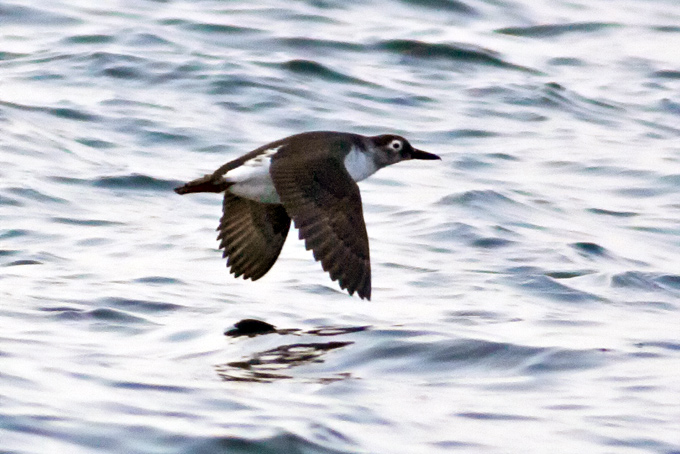 Spectacled Guillemot Cepphus carbo, © Tim Edelsten
Spectacled Guillemot Cepphus carbo, © Tim Edelsten - Long-billed Murrelet Brachyramphus perdix. One seen from the headland at Geojin on the 15th was followed by three seen from the boat on the 16th.
- Ancient Murrelet Synthliboramphus antiquus. Several hundred were seen offshore on the 16th, when at close quarters they were heard to give their soft and barely audible cheeping cries.
 Ancient Murrelet Synthliboramphus antiquus, © Tim Edelsten
Ancient Murrelet Synthliboramphus antiquus, © Tim Edelsten - Least Auklet Aethia pusilla. An unprecedented count of 12 from the boat off Hwajinpo on the 16th is easily a new national high count. It even exceeds the total number of previous records and also individual records. This number included two flocks of three and other individuals which were seen excellently at close quarters and photographed. Interestingly they were seen to fly with a distinctive see-sawing motion and also show much variation in the amount of white on the scapulars.
 Least Auklet Aethia pusilla, © Tim Edelsten
Least Auklet Aethia pusilla, © Tim Edelsten Least Auklet Aethia pusilla, © Tim Edelsten
Least Auklet Aethia pusilla, © Tim Edelsten - Common Kingfisher Alcedo atthis. One on the river below the dam wall at Chungju on the 17th.
- Great Grey Shrike Lanius excubitor. We re-found and photographed the much-vaunted Seosan juvenile on the 17th. It gave good views before pouncing on a mouse and then disappearing with it in its claws. This bird was initially found by Shim Kyu-Sik on December 29th 2013.
 Great Grey Shrike Lanius excubitor, © Tim Edelsten
Great Grey Shrike Lanius excubitor, © Tim Edelsten - Chinese Grey Shrike Lanius sphenocercus. One seen at Seosan on the 17th, holding territory adjacent to the aforementioned Great Grey.
- Azure-winged Magpie Cyanopica cyanus. A group seen near Sancheong, Gyeongsangnam Province.
- Eurasian Skylark Alauda arvensis. A restless flock of up to 20 in ricefields at YangYang on the 15th.
- Japanese White-eye Zosterops japonicus. Four seen near Sancheong in Gyeongsangnam Province on the 13th.
- Red-flanked Bluetail Tarsiger cyanurus. One sen "tutting" in scrub at at Jinyoung Lake on the 14th.
- Blue Rock Thrush Monticola solitarius. One in Daejin harbour.
- Siberian Accentor Prunella montanella. One at Gyeongpo Lake, Gangneung on the 15th and one at Daejin Lighthouse on the 6th.
- Japanese Wagtail Motacilla grandis. Widespread and fairly common throughout, e.g. at Gyeongpo lake, Gangneung, on the 15th and at Chungju reservoir on the 17th- where singing.
- Buff-bellied Pipit Anthus rubescens. Only one, on the river at Chungju.
- Hawfinch Coccothraustes coccothraustes. One at Jinyoung Lake.
- Long-tailed Rosefinch Carpodacus sibiricus. Two at the Namdaecheon, YangYang on the 15th.
- Common Redpoll Acanthis flammea. Two seen at Sokcho on the 13th by Jang Ji-Eung were followed by two at Daejin lighthouse on the 16th.
Chungju, January 14
Korea's first Ring-necked Duck Aythya collaris was found on January 13 and still present today.

Usop Swamp (Naju), January 9




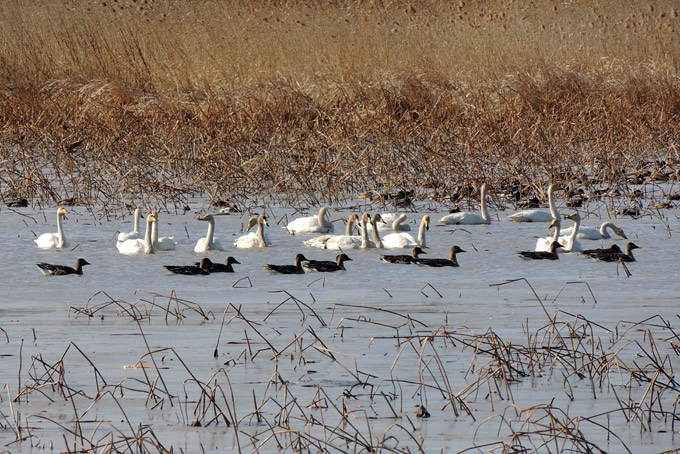


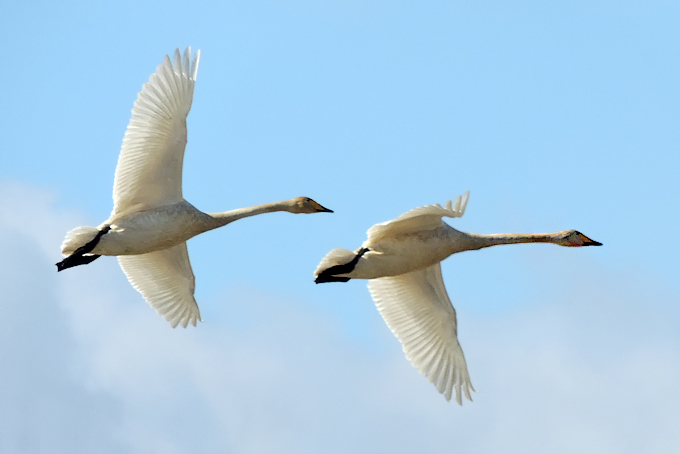

On the way also passing the little Shinhwon lake which had c. 100 Mallard, 17 Falcated Teal and 1 Northern Pintail.
Also on the way at the Jayeonbu lake near Illu 5 Long-billed Plover.

Jungnang Stream, January 6
Again at Eungbong, but the main attraction - the Ferruginous Duck - has left. There remains an assortment of waterfowl, which seem a bit different to previous years, including the following:
- Greater White-fronted Goose Anser albifrons. One lost-looking juvenile is the first I have seen here.
- Ruddy Shelduck Tadorna ferruginea. Eight. This is the first winter that they've appeared here.
- Mandarin Duck Aix galericulata. 129 counted. In unusually high numbers here this year.
- Mallard Anas platyrhynchos. (Photographed).
- Eurasian Teal Anas crecca. (Photographed).
- Common Pochard Aythya ferina. 1400 at the mouth of the stream.
- Tufted Duck Aythya fuligula. 800 at the confluence-avoiding the area which was dredged last year.
- Little Grebe Tachybaptus ruficollis. Three: another apparent first record for this site.
- Great Crested Grebe Podiceps cristatus. 11 where the stream meets the Han. Another species I've never seen here previously.
- Great Cormorant Phalacrocorax carbo. There were 5-600 here on the 1st. An unprecedented number for this site.
- Peregrine Falcon Falco peregrinus. One 1Y bird. Rarely recorded in the Seoul city area.
- Eurasian Coot Fulica atra. Three -a scarce record for this particular site.
- Common Sandpiper Actitis hypoleucos. One.
- Vega Gull Larus vegae. One contrasting clearly with the 20 or so Mongolian Gulls. Unusual to see one so far inland.

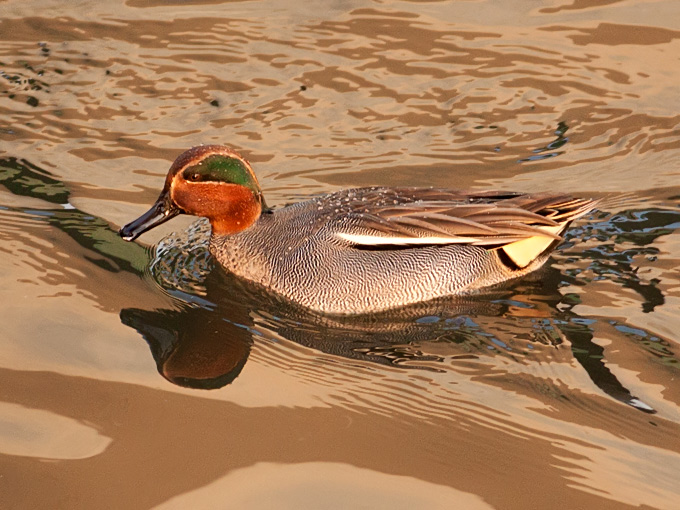
Naju and Haenam, January 5
Mr. Jason Loghry and I surveyed the area around Naju and Haenam County in southern Jeollanam-do. The weather was clear skies throughout the day, with a continuous light wind in Haenam; despite the sunlight, it was still quite cold and standing in one place for a long time was not to be the order of the day.
We covered a lot of ground and were rewarded with some fantastic birds for our efforts. A complete list of the days sightings is below. A total of 49 species were observed throughout the day.
- Taiga Bean Goose Anser fabalis
- Tundra Bean Goose Anser serrirostris
- Greater White-fronted Goose Anser albifrons; c. 2,000-3,000 birds around Gocheonnam Lake in Haenam – both the nominate and A. a. frontalis subspecies were represented
- Lesser White-fronted Goose Anser erythopus; two, up to 5, were observed hidden in with the Greater White-fronted Geese
- Common Shelduck Tadorna tadorna
- Gadwall Anas strepera
- Eurasian Wigeon Anas penelope
- Mallard Anas platyrhynchos
- Eastern Spot-billed Duck Anas zonorhyncha
- Northern Pintail Anas acuta
- Common Teal Anas crecca
- Common Merganser Mergus merganser
- Red-breasted Merganser Mergus serrator
- Scaly-sided Merganser Mergus squamata
- Little Grebe Tachybaptus ruficollis
- Great Crested Grebe Podiceps cristatus
- Grey Heron Ardea cinerea
- Eastern Great Egret Ardea modesta
- Great Cormorant Phalacrocorax carbo
- Cinereous Vulture Aegypius monachus
- Eastern Marsh Harrier Circus spilonotus
- Hen Harrier Circus cyaneus; included a beautiful adult male
- Eastern Buzzard Buteo japonicus; very numerous
- Common Kestrel Falco tinnunculus
- Merlin Falco columbarius; JL only
- Peregrine Falcon Falco peregrinus
- Eurasian Coot Fulica ater
- Grey Plover Pluvialis squatarola
- Green Sandpiper Tringa glareolus
- Common Snipe Gallinago gallinago; JL only
- Vega Gull Larus vegae
- Mongolian Gull Larus mongolicus
- Oriental Turtle Dove Streptopelia orientalis
- Grey-headed Woodpecker Picus canus; heard only near Naju
- Bull-headed Shrike Lanius bucephalus
- Eurasian Jay Garrulus glandarius
- Azure-winged Magpie Cyanopica cyanus
- Eurasian Magpie Pica pica
- Eurasian Skylark Alauda arvensis
- Brown-eared Bulbul Hypsipetes amaurotis
- Vinous-throated Parrotbill Sinosuthora webbiana
- White-cheeked Starling Spodipsar cineraceus
- Dusky Thrush Turdus eunomus
- Daurian Redstart Phoenicurus auroreus; JL only
- Eurasian Tree Sparrow Passer montanus
- Grey Wagtail Motacilla cinerea
- Olive-backed Pipit Anthus hodgsoni
- Buff-bellied Pipit Anthus rubescens
- Yellow-throated Bunting Emberiza elegans
- Pallas’s Reed Bunting Emberiza pallasi



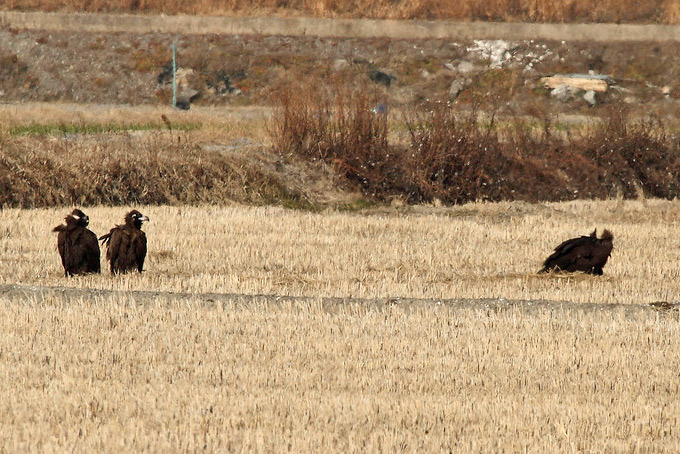
Stream near Eungbong Station, January 1
There was a nice assortment of ducks on a small stretch of river feeding into the Han, with most regular winter ducks represented. Notable were about 150 Mandarin Ducks, remarkable for this site. The star attraction was a cracking male Ferruginous Duck, looking spectacular as it swam lazily in the sun.
